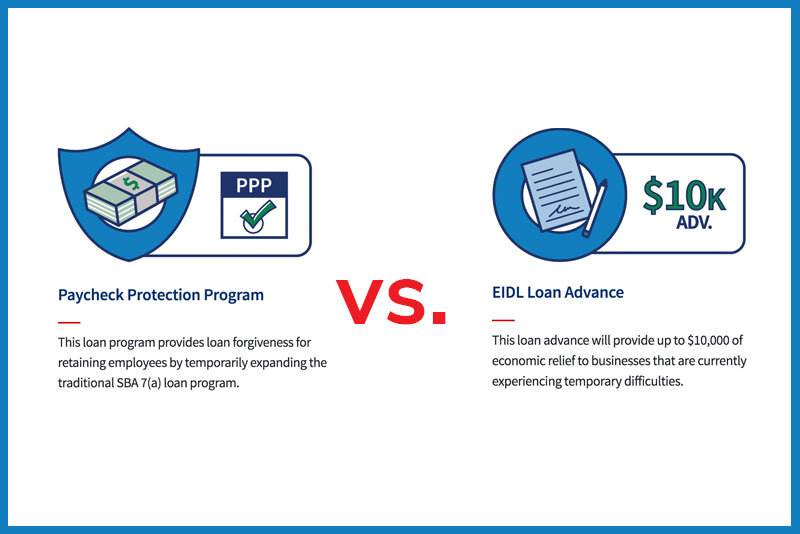Can’t decide whether you should apply for the Paycheck Protection Program (PPP) loan from the SBA or the Economic Injury Disaster Loan (EIDL) from the U.S. Treasury? Truth be told, many of your fellow small business owners have already turned in their applications for one or both and some are starting to receive their funding. If you’re still trying to sort out the differences or seeing if some of the confusion gets resolved, maybe we can help. Here’s what we know.
Paycheck Protection Program (PPP)
You probably already know the basics of the PPP, but it bears going over again for comparison to your other relief options.
Established by the CARES Act, the PPP provides small businesses with the funds to pay up to eight weeks of payroll costs including benefits. The funds can also be used to pay interest on rent, mortgage interest, utility costs for the business and interest on “any other debt obligations that were incurred before February 15, 2020. If the right conditions are met, the entire loan amount may be forgiven. The PPP is available through June 30, 2020. As of April 13, 2020, the SBA has guaranteed 1,035,086 loans under the PPP.
The maximum PPP loan amount is 2.5 times your business’s average monthly payroll costs, up to $10 million. Business owners can receive only one PPP loan.
Eligible Businesses
- Must be a small business with fewer than 500 employees including independent contractors, sole proprietors, self-employed, LLCs, S Corps, C Corps and partnerships.
- Eligible non-profits (501c3), veteran organizations (501c19) and tribal businesses (31b2C) are also eligible.
Details of the Loan
- Provides eight weeks of average monthly payroll costs including salary, wages, commissions, tips, employee benefits including costs for vacation, parental, family medical or sick leave (capped at $100K per employee)
- Sole proprietors will calculate their “payroll” based on wages, commissions, income, or net earnings from self-employment (capped at $100K)
- Seasonal businesses will calculate based on average monthly payroll costs between February 15, 2019, or March 1, 2019, and June 30, 2019 (capped at $100K per employee).
- New 2020 businesses will calculate based on average monthly payroll costs from January 1, 2020 to February 29, 2020 (capped at $100K per employee).
- 75 percent of the loan must be used for payroll costs; 25 percent can be used for rent, interest and business utilities.
Documentation Required
- Proof your business was in operation on February 15, 2020.
- Proof your business had employees (or in the case of self-employment, income)
- Verification of average monthly payroll costs (such as tax forms, payroll statements, etc.)
Not Needed
- No collateral required
- No personal guarantee required
- No SBA Fees
- No agent fees
To Have a PPP Loan Forgiven
- 75 percent of loan must be used for payroll costs; 25 percent can be used for rent, interest and business utilities.
- Number of employees must be maintained
- Salaries must be maintained
- Borrowers must submit a written request for forgiveness from a lender and provide documents verifying employee retention, salaries, payments on rent, interest, and utilities. Lenders have 60 days to respond.
To repay portion not forgiven, borrowers have a 2-year repayment term at a 1 percent interest rate.
How to Apply
Through an SBA approved lender.
Economic Injury Disaster Loan (EIDL)
Previously granted to those affected by major natural disasters, the Economic Injury Disaster Loan (EIDL) is now available, with relaxed restrictions, for those affected by the coronavirus pandemic. Small businesses may now apply for an EIDL loan of up to $2 million from the federal government through December 31, 2020. Applicants can also apply for a $10,000 Economic Injury Disaster Loan Emergency Advance.
To ensure that the greatest number of applicants can receive assistance, the amount of your Advance will be determined by the number of employees you had before the onset of the coronavirus (i.e., as of January 31, 2020). The Advance will provide $1,000 per employee up to a maximum of $10,000.
Eligible Businesses
- Must be a small business with fewer than 500 employees including independent contractors, sole proprietors, self-employed, LLCs, S Corps, C Corps and partnerships, cooperatives and ESOPs.
- Eligible non-profits (501c3), veteran organizations (501c19) and tribal businesses (31b2C) are also eligible.
EIDL Details
- Loan maximum is $2 million
- Interest rate for small businesses is 3.75 percent, for nonprofits 2.75 percent.
- Terms up to 30 years
- Funds must be used for fixed debts (rent, etc.), payroll, accounts payable and other bills unpaid due to disaster.
- Until December 31, 2020 there is no requirement for personal guarantees on EIDL loans less than $200,000.
- Until December 31, 2020 there is no requirement for the borrower to have been in business for at least a year.
- Until December 31, 2020 there is no requirement that borrowers are unable to obtain credit from other sources.
- The loan cannot be used for dividends, bonuses, disbursements to owners, repayment of stockholder/principal loans (with exceptions), expansion of facilities or acquisition of fixed assets, repairs or replacement of physical damages, refinancing long-term debt, repaying loans, relocation.
- A business must define its loss in comparison to its 2019 operations.
Documentation Required
- Borrowers will need to provide documentation showing gross revenues, cost of goods sold, lost rents (for rental property owners), cost of operating expenses (for nonprofits), other reimbursements such as business interruption insurance, number of employees
- SBA Loan Application (SBA Form 5 or 5C)
- Personal Financial Statement (SBA Form 413)
- Schedule of Liabilities (SBA Form 2202)
- Tax Information Authorization (IRS Form 4506T)
- The lender may also ask for federal income tax returns (with schedules) for principals, general partners or managing member, and affiliates for 3 years, profit and loss statement and balance sheet.
EIDL FAQs
What if I am self-employed and have no employees on payroll?
You can still apply for the EIDL. List yourself as the sole employee. You will be capped at $1000 for the EIDL Loan Advance according to the SBA. And note, in order to qualify for even the $1000 loan advance you must be filing as a Schedule C on your tax return.
What if I am a self-employed independent contractor with no employees on payroll?
You can still apply for the EIDL. List yourself as an IC on the application. You will be capped at $1000 for the EIDL Loan Advance according to the SBA. And note, in order to qualify for the $1000 loan advance, you must be filing as a Schedule C on your tax return.
What if I have fewer employees on payroll than I had before the coronavirus outbreak?
A: You can still apply for the EIDL and the amount of your Advance will be determined by the number of employees you had before the outbreak of the coronavirus (i.e., as of January 31, 2020) employees. The Advance will provide $1,000 per employee up to a maximum of $10,000.
What if I am self-employed with no employees on payroll and I’m showing a loss on my schedule C?
According to the SBA, you would not qualify.
Summing up, according to the SBA business owners, which includes C Corporations. S Corporations, LLCs, Sole Proprietors, and Partnerships are eligible to apply for the EIDL and the EIDL Loan Advance as long as they were in business prior to January 31, 2020 and had employees as of January 31, 2020.
If they are a Sole Proprietor, IC, Single Member LLC, C Corp, S Corp, or in a partnership with no employees on payroll, they should list themselves as the only employee and will be capped at $1000 for the loan advance.
To Have an EIDL Loan Forgiven
Only the $10,000 EIDL advance is eligible to be completely forgiven, if the borrower spends the money on payroll costs, higher costs for supplies due to supply chain disruption, mortgage and rent costs.
If the borrower already has an SBA loan, they can ask the lender to defer principal and interest payments for up to six months. The SBA will pay the principal, interest, and fees owed to lenders.
How to Apply
Through the SBA.
PPP or EIDL?
You can apply for both the PPP and the EIDL, however, you are restricted from using the program funds for the same purpose, for example, payroll. Also, if you use the money for payroll then you cannot later take the tax credit for those costs under the Families First Coronavirus Response Act.
The differences between the PPP and the EIDL have to do with the amount of money you need and what you plan on using the money for. The PPP helps you cover payroll costs for eight weeks so you can maintain your staff and keep people working. The EIDL is a loan meant to cover six months of operational expenditures.
If you have already collected the EIDL advance grant, you are still eligible to apply for a PPP loan (to use for different expenses). If you want to use part or all of the EIDL for payroll costs, you can refinance the EIDL loan into the PPP loan. However, once you add that amount to the PPP loan any funds above what you received for the original PPP would not be forgiven.
Also, important to note: If you receive finds from the EIDL advance grant and do not get approved for the EIDL loan, you still can keep the grant.
CorpNet Is Here to Help
CorpNet remains open and in full operation Monday through Friday from 7 a.m. until 5:00 p.m. PST to help. Our team is safely self-distanced and set up to work remotely with all of the necessary tools and resources to serve you. Contact us today at 1-888-449-2638 to discuss how we can help you.





